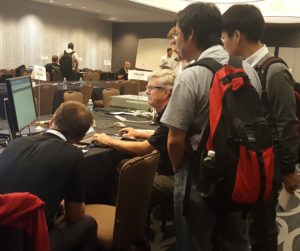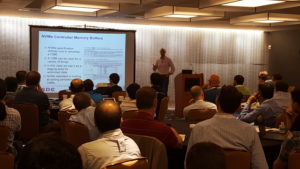 Read More
Read More
Experts Answer Virtualization and Storage Networking Questions
 Read More
Read More
 Read More
Read More
 Ever make a mistake configuring a storage array or wonder if you’re maximizing the value of your virtualized environment? With all the different storage arrays and connectivity protocols available today, knowing best practices can help improve operational efficiency and ensure resilient operations. That’s why the SNIA Networking Storage Forum is kicking off 2019 with a live webcast “Virtualization and Storage Networking Best Practices.”
In this webcast, Jason Massae from VMware and Cody Hosterman from Pure Storage will share insights and lessons learned as reported by VMware’s storage global services by discussing: Read More
Ever make a mistake configuring a storage array or wonder if you’re maximizing the value of your virtualized environment? With all the different storage arrays and connectivity protocols available today, knowing best practices can help improve operational efficiency and ensure resilient operations. That’s why the SNIA Networking Storage Forum is kicking off 2019 with a live webcast “Virtualization and Storage Networking Best Practices.”
In this webcast, Jason Massae from VMware and Cody Hosterman from Pure Storage will share insights and lessons learned as reported by VMware’s storage global services by discussing: Read More
SNIA’s 18th Storage Developer Conference is officially a success, with 124 general and breakout sessions; Cloud Interoperability, Kineti c Storage, and SMB3 plugfests; ten Birds-of-a-Feather Sessions, and amazing networking among 450+ attendees. Sessions on NVMe over Fabrics won the title of most attended, but Persistent Memory, Object Storage, and Performance were right behind. Many thanks to SDC 2016 Sponsors, who engaged attendees in exciting technology discussions.
c Storage, and SMB3 plugfests; ten Birds-of-a-Feather Sessions, and amazing networking among 450+ attendees. Sessions on NVMe over Fabrics won the title of most attended, but Persistent Memory, Object Storage, and Performance were right behind. Many thanks to SDC 2016 Sponsors, who engaged attendees in exciting technology discussions.
For those not familiar with SDC, this technical industry event is designed for a variety of storage technologists at various levels from developers to architects to product managers and more. And, true to SNIA’s commitment to educating the industry on current and future disruptive technologies, SDC content is now available to all – whether you attended or not – for download and viewing.
 You’ll want to stream keynotes from Citigroup, Toshiba, DSSD, Los Alamos National Labs, Broadcom, Microsemi, and Intel – they’re available now on demand on SNIA’s YouTube channel, SNIAVideo.
You’ll want to stream keynotes from Citigroup, Toshiba, DSSD, Los Alamos National Labs, Broadcom, Microsemi, and Intel – they’re available now on demand on SNIA’s YouTube channel, SNIAVideo.
All SDC presentations are now available for download; and over the next few months, you can continue to download SDC podcasts which combine audio and slides. The first podcast from SDC 2016 – on hyperscaler (as well as all 2015 SDC Podcasts) are available here, and more will be available in the coming weeks.
SNIA thanks all its members and colleagues who contributed to make SDC a success! A special thanks goes out to the SNIA Technical Council, a select group of acknowledged industry experts who work to guide SNIA technical efforts. In addition to driving the agenda and content for SDC, the Technical Council oversees and manages SNIA Technical Work Groups, reviews architectures submitted by Work Groups, and is the SNIA’s technical liaison to standards organizations. Learn more about these visionary leaders at http://www.snia.org/about/organization/tech_council.
And finally, don’t forget to mark your calendars now for SDC 2017 – September 11-14, 2017, again at the Hyatt Regency Santa Clara. Watch for the Call for Presentations to open in February 2017.
I continue to believe that IP based storage protocols will be preferred for future data center deployments. The future of IT is pointing to cloud based architectures, whether internal or external. At the core of the cloud is virtualization. And I believe that Ethernet and IP storage protocols offer the greatest overall value to unlock the potential of virtualization and clouds. Will other storage network technologies work? Of course. But, I’m not talking about whether a network “works”. I’m suggesting that a converged network environment with Ethernet and IP storage offers the best combined value for virtual environments and cloud deployments. I’ve written and spoken about this topic before. And I will likely continue to do so. So, let me mention a few reasons to choose IP storage, iSCSI or NAS, for use in cloud environments.
Mobility. One of the many benefits of server virtualization is the ability to non-disruptively migrate applications from one physical server to another to support load balancing, failover or redundancy, and servicing or updating of hardware. The ability to migrate applications is best achieved with networked storage since the data doesn’t have to move when a virtual machine (VM) moves. But, the network needs to maintain connectivity to the fabric when a VM moves. Ethernet offers a network technology capable of migrating or reassigning network addresses, in this case IP addresses, from one physical device to another. When a VM moves to another physical server, the IP addresses move with it. IP based storage, such as iSCSI, leverages the built in capabilities of TCP/IP over Ethernet to migrate network port addresses without interruption to applications.
Flexibility. Most data centers require a mixture of applications that access either file or block data. With server virtualization, it is likely that you’ll require access to file and block data types on the same physical server for either the guest or parent OS. The ability to use a common network infrastructure for both the guest and parent can reduce cost and simplify management. Ethernet offers support for multiple storage protocols. In addition to iSCSI, Ethernet supports NFS and CIFS/SMB resulting in greater choice to optimize application performance within your budget. FCoE is also supported on an enhanced 10Gb Ethernet network to offer access to an existing FC infrastructure. The added flexibility to interface with existing SAN resources enhances the value of 10Gb as a long-term networking solution.
Performance. Cost. Ubiquity. Other factors that enhance Ethernet storage and therefore IP storage adoption include a robust roadmap, favorable economics, and near universal adoption. The Ethernet roadmap includes 40Gb and 100Gb speeds which will support storage traffic and will be capable of addressing any foreseeable application requirements. Ethernet today offers considerable economic value as port prices continue to drop. Although Gb speeds offer sufficient bandwidth for most business applications, the cost per Gb of bandwidth with 10 Gigabit Ethernet (GbE) is now lower than GbE and therefore offers upside in cost and efficiency. Finally, nearly all new digital devices including mobile phones, cameras, laptops, servers, and even some home appliances, are being offered with WiFi connectivity over Ethernet. Consolidating onto a single network technology means that the networking infrastructure to the rest of the world is essentially already deployed. How good is that?
Some may view moving to a shared network as kind of scary. The concerns are real. But, Ethernet has been a shared networking platform for decades and continues to offer enhanced features, performance, and security to address its increased application. And just because it can share other traffic, doesn’t mean that it must. Physical isolation of Ethernet networks is just as feasible as any other networking technology. Some may choose this option. Regardless, selecting a single network technology, even if not shared across all applications, can reduce not only capital expense, but also operational expense. Your IT personnel can be trained on a single networking technology versus multiple specialized single purpose networks. You may even be able to reduce maintenance and inventory costs to boot.
Customers looking to architect their network and storage infrastructure for today and the future would do well to consider Ethernet and IP storage protocols. The advantages are pretty compelling.